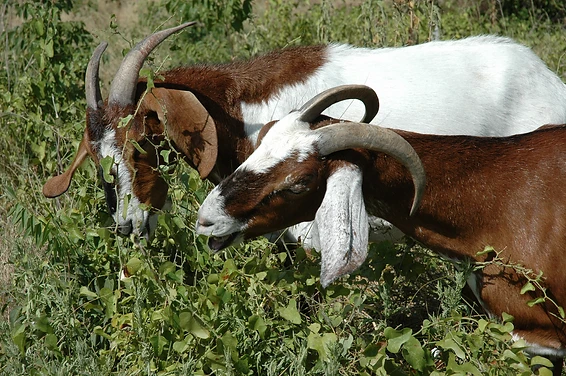
Your goats have unique feeding habits. They like to eat a variety of feeds (often a mixture of leaves). They select leaf tips that are located high up the ground. The two main types of forages for goats are:
- Grasses - plants with narrow and pointed leaves and are either upright or creeping (short).
- Napier (Pennisetum purpureum) is an example of a tall upright grass species.
- Guinea grass (Panicum maximum) is a medium-height upright species.
- Humidicola (Brachiaria humidicola) is a short, creeping grass species.
- Broadleaves - plants with irregularly shaped broad leaves and are either:
- Herbs - short-growing plants with succulent stems
- Shrubs - plants with woody stems and grow up to 3m height; or
- Trees - plants with woody trunks and stems that grow to more than 3m
Comparison of Types
Grasses and broad leaves have different features that enable them to grow differently.
Because of their shallow roots, grasses die out in the dry season. However, they can grow quickly and produce a lot of feed in the wet season.
Broad leaves on the other hand grow slower but can provide your goats with feed even in the summer. Moreover, they are good sources of protein. Among the broad leaves, legumes can supply your goats with higher protein.
Grasses grow old quicker than broadleaves if left uncut. However, under good conditions, grasses provide more feed per unit area than broadleaves.
Commonly Grown Forages
The following are commonly grown forage species for goats. Be sure to identify which of these are abundantly growing in your area and which can be accessed freely from somewhere else:
Grasses
- Creeping
- Humidicola (Brachiaria humidicola)
- Star Grass (Cynodon nlemfuensis)
- Upright grasses
- Napier Grass (Pennisetum purpureum)
- Gamba Grass (Andropogon gayanus) is a medium upright grass that can grow well even in soils that have low fertility.
- Guinea grass (Panicum maximum) is a medium upright grass that provides good quality feed.

- Paspalum (Paspalum atratum) is a medium upright grass that grows well in wet areas.
- Setaria (Setaria splendida) is a medium upright grass that requires moderate soil fertility.
- Herbs
- Arachis (Arachis pintoi)Among the herbaceous legumes, Arachis is the creeping type.
- Centro (Centrosema pubescens)is a twining, climbing vine.
- Stylo (Stylosanthes guianensis)has a trailing growth habit.
- Shrubs
- Desmanthus (Desmanthus virgatus)
- Rensoni (Desmodium cineria)
- Tricanthera (Tricanthera gigantea)is a broadleaf shrub species that is not a legume but is well-liked by goats.
- Trees
- Calliandra (Calliandra calothyrsus)
- Kakawate (Gliricidia sepium)
- Ipil-ipil (Leucaena leucocephala)
Not all forage species can grow well in your area. The climate and soil in your farm determine, in part, what forage species can be grown. But are you aware of the type of soil that you have? The best way is to do soil analysis. In the absence of this analysis, you can use the following simple indicators:
Indicators
- If your soil is reddish and ipil-ipil (Leucaena) is not abundant, the soil is probably acidic.
- Your soil is also acidic when neighboring farms apply lime to their crops.
- If your soil is blackish on the surface and gets whitish, stony, limy, or have coral-like materials as you dig deeper, then it is alkaline.
- If ipil-ipil (Leucaena) grows abundantly, then your soil is alkaline.
- If plants grow well in your area, then your soil is fertile.
- Ipil-ipil and Desmanthus grow well in neutral and calcareous soils but not in acid soils.
- Stylo can not be grown in alkaline soils but grows well even in acid and infertile soils.
- Napier, Guinea and Paspalum need fertile soil to grow well.
- Humidicola, gamba and stargrass can grow well in low fertility soils.
- Humidicola and Paspalum can tolerate intermittent flooding.
If your area is limited, you can integrate the forages in your farm; however, manage your forages differently. Here is a guide in integrating the different species in your farm:
- As covercrop. Plant Humidicola, Stargrass, Arachis, Centro and Stylo under crops or trees to serve as cover crops
Their spreading growth habit provide the standing crops protection from weeds and erosion.
- As intercrop. Forages can be grown in between crops. When grown as such, provide additional soil nutrients and change the management to avoid affecting the other crops.
When forages like Guinea grass is planted between crops, regularly prune both the forage and the main crop.
Forages like Stylo (Stylosanthes guianensis) can be grown under cassava as long as there is adequate light available.
- As firebreak.Plant humidicola around the farm to serve as firebreak in areas where dry season fires often occur.
In many areas dominated by grasses, grass fires commonly occur in the dry season.
As Humidicola (Brachiaria humidicola) forms a dense mat that retains water even in the dry season, it thus serves an effective firebreak around crop fields.
- As rotational crop. Use forage legumes like Arachis, Centro and Stylo in rotation with crops to regain soil fertility.
- As hedgerow.Plant upright forages, such as Calliandra, as hedgerows along contours to control erosion.
Upright grasses like Setaria can be also planted as contour hedgerows in hilly areas to control erosion while providing feed to goats.
- As boundary marker. Use other upright forage species as boundary markers or fence-lines.
- As bunds. Forages can also be planted in bunds along rice paddies, fishponds and riverbanks.
Humidicola, Stargrass and Arachis grow by creeping. They produce new plants from nodes in their stems. Because of this, they can withstand trampling and can regrow quickly, making them suitable for heavy grazing.
Gamba, Guinea, Paspalum, Setaria, Stylo and Tricanthera grow up to medium heights. These species are best used for cut-and-carry feeding or grazing at controlled levels.
Napier and all broadleaves except Arachis, Centro and Stylo grow up to tall heights. They are best used for cut-and-carry feeding.









0 Comments